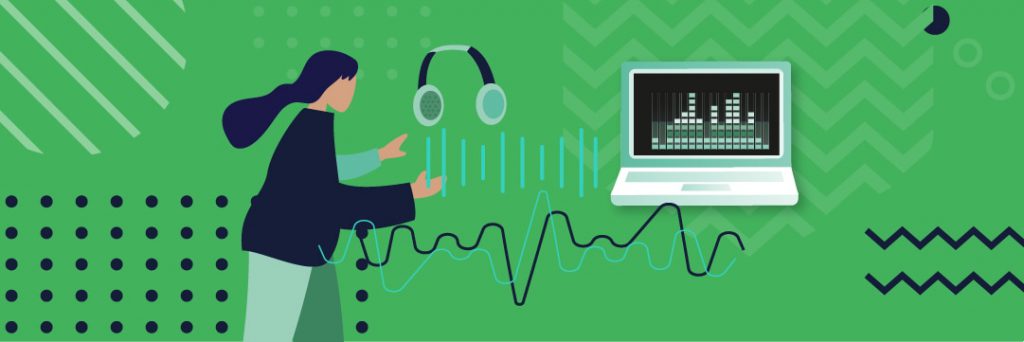Have you ever asked yourself, what does sound look like? Well, an audio waveform visualizer can give you a pretty good idea.
You’ve probably seen an audio waveform before; when playing a song on your phone, when recording the sound of your voice, and if you are a video editor, chances are you work with waveforms all the time.
Audio waveform visualizers combine the elements of art, graphic design, and technology to show viewers a representation of the sound they are listening to.
Audio Visualization and its Benefits
We all know the benefits of video as an entertainment as well as an advertising medium. Video has the potential to connect with your viewers emotionally and make them engage with your content more.
If you don’t have the right equipment or the budget for a video editor, it can be challenging to create online videos.
Power of Audio
Audio is already a powerful medium on its own. This is why there are 850,000 active podcast programs in the world. Usually, podcast content creators like to release a video-recorded session along with the audio.
Video, however, can be challenging to create. Not to mention the video editing process which can be tiresome and technical.
If you don’t have the right equipment or the budget for a video editor, creating online videos can feel overwhelming.
So what do you do when you have to put out a video but don’t have the budget for it?
It’s easy – you use audio visualization.
Here is a similar guide on audiovisual aids: the good, the bad, and the memorable.
Audio waveform animation has the following advantages:
Increase Video Engagement
Social media is all about visuals. 83% of people watch their videos on mute, so you need to have something interesting happening on the screen.
Audio waveform animations visually enforce the sound, making the video more appealing to the audience.
Saves You Time and Money
When shooting a video, you need to worry about the equipment, lighting, and even your appearance.
With audio waveform visualizers, you only need to focus on the audio. You can fit a waveform into your animation within a few minutes, and this is great because it means you can release your content consistently.
But audio waveforms are not just meant for visual appeal.
Audio Waveforms and Video Editors
Audio waveforms are a blueprint for both video and audio editors.
You know why?
These graphs show you where the sound is too loud, where it is too low, and where there is no sound at all. You can isolate parts of the waveform and either cancel the noise or enhance the sound.
Video and audio editors have so much more freedom to edit with the help of audio waveforms.
Great Alternative for Video
Even after planning a video shoot for months, it should come as no surprise if something goes wrong at the last minute. These things happen, and if you still have to stick on schedule, consider using an audio waveform visualizer instead.
Waveform animations are a great alternative to video because they are also engaging and visually appealing.
Rather than putting out an audio file without an accompanying image, it is better to publish a visualizer instead. This way, even your audience sees that you put in some effort into the production process.
Branded Content
Establishing a brand identity is as simple as using your brand colors consistently, and including your logo in every visual.
Audio waveform animation comes in handy especially when you are using your social media videos for business.
Audio waveform animation provides you the perfect chance to brand your audio content.
All you have to do is use striking visuals that instantly catch the attention of the audience.
How Does an Audio Waveform Visualizer Work?
An audio waveform visualizer works by extracting frequency information from the audio and feeding this data through some display rules.
Audio waveform visualizers create animated waveforms (audiograms) that shift with the rhythm, loudness, and frequency of the audio.
These rules are pre-determined by the programmer, but the final output is based on the frequency characteristics of the audio.
These applications are popular among video marketers because they are easy to use and produce beautiful visuals for social media videos.
Audio waveform visualizers create animated waveforms (audiograms) that shift with the rhythm, loudness, and frequency of the audio.
Audio waveforms are bright, multicolored, and instantly responsive images.

How to Create an Audio Waveform
The revolutionary technique of audio waveform animation was pioneered back in the 70s. Creatives discovered that electronic signals can generate complex visuals, and for the first time ever, elements like frequency could be mapped onto shapes and colors.
By the time the digital era arrived, audio waveform visualization had taken on a new life.
It became the norm for these animations to use hypnotic and psychedelic visuals.
Today, modern audio waveform visualizers take it a notch higher and combine score information with notations to create stunning visuals like in this example here.
There are multiple ways to create an audio waveform animation using different software. It all depends on these three factors:
- Your level of expertise
- The level of control you want to have over the creation of the waveform
- The needs of your audience
If you want more control over your work, it’s best to use video editing software like Adobe After Effects or Adobe Premiere.
Using Adobe After Effects
With this software, you can layer different effects over the waveform to create stunning visuals.
To use this software for audio waveform visualization, follow the following instructions:
- Drag your audio into your current composition.
- Create a new layer by opening the ‘Effects & Presets’ panel. Click on ‘Generate > Audio Spectrum.’
- You can customize other settings like the color, the hue, thickness of the waveform, start and end frequency, and even toggle between different display options.
- You can use this or any other video editing software if you have an idea of the waveform you want to create.
The other method of creating audio waveforms involves:
Using web-based audio waveform visualizer applications.
There are many sites you can visit to create an eye-catching waveform. These online applications provide free pre-designed waveform templates that you can choose from.
Wavve, for instance, is an audio waveform visualizer based on the web. This application allows users to combine their clips with an image and a pre-designed waveform that moves with the audio.
Using web-based audio waveform visualizers is easy:
- The first step is to upload your raw footage by dragging and dropping it.
- The second step involves adding the waveforms and audiograms to your audio.
- To do this, simply select the video editor on the timeline and adjust the start and endpoint of the video. Finally, select the waveform that suits your audio and edit it to your preference.
- Once you are done with your edits and cross-checked that everything is perfect, you can go ahead and download your video with just a click.
One of the best things about these web-based sites is that most of them support multiple file formats. Waveform visualizer applications also provide a variety of audiogram designs that vary in terms of color, size, and shape.
Go for an audio waveform visualizer that can allow you to easily share your files on different social media accounts.
Here are other online-based music visualizers you can use:
- Renderforest Music Visualizer
- SongRender Music Visualizer
- Videobolt Music Visualizer
All these audio waveform visualizers have an intuitive and easy-to-use interface. You can create your visuals in just a few clicks.
Visualization allows creators to experiment with different concepts without having to commit to a plot.
Everything else You Should Know About Visualization
Audio waveforms are not the only types of music visualizers.
There are four basic types of audio waveforms:
- Sine
- Triangle
- Square
- Sawtooth
These waveforms represent audio frequency, with the sine waveform being the simplest of them all.
Some History
It has become a trend for musicians to release lyric videos, official music videos, and visualizers. It makes sense from a marketing perspective – those who don’t want to watch the video can stream the visualizer version instead.
Before the age of visualization, artists would release an album cover image that would accompany the songs across all streaming services, but that is not the case anymore.
Visualization allows creators to experiment with different concepts without having to commit to a plot.
Usually, artists create visualizers by editing a few seconds of their video and putting it on a loop. It can even be an image on the screen, but with a moving background or graphics.
The Downside of Visualization
All new and exciting trends run the risk of being overused or misused, and audio waveform visualizers are no different.
Overusing waveforms visualizers might make users see them as placeholders instead of fully immersive visuals.
Where to use Audio Waveform Visualization
- You can use waveform animations to connect with your listeners on a deeper level. In the case of a high-energy song, you can use the bass drop music visualizer that makes listeners feel more powerful.
- You can use audio waveforms to promote your website and increase engagement.
- You can use these waveforms to increase the visual appeal of your social media videos.
Elevate Your Sound
Waveform animations are engaging, and if depending on their level of complexity, these visualizers can draw the audience further into the audio.
Audio waveform visualizers are less developed than music videos, making them cheaper and easier to produce. Do you have a new podcast episode or a new song that you want to release soon? Take advantage of these simplistic visuals and elevate your sound with audio waveform animation.











